#silesaur
Explore tagged Tumblr posts
Text

DINOVEMBER 1/13: Gondwanax paraisensis
Hello everyone! I'm doing Dinovember again this year, but a little differently. I'll only be doing 3 drawings a week (ish) in order to pace myself, as in past years going the full 30 hasn't worked for me. As per usual, I'll be following my own list which is sorted oldest-youngest, with the focus this year being on new discoveries.
Talking of new discoveries, Gondwanax was only described in September this year from a femur (and other potentially assignable scraps) found in Brazil's Santa Maria formation. Gondwanax was one of the oldest known dinosauromorphs at 240Ma-230Ma, rivalling animals like Nyasasaurus, the closely related Asilisaurus from Tanzania and furthering our knowledge of the origins of dinosauria.
Gondwanax has been identified as a silesaur, a group of primarily herbivorous archosaurs which it looks increasingly like are actually the long sort-after Triassic representatives of the ornithischian dinosaurs. The phylogeny of Gondwanax published in it's description supports this, placing it and the rest of "silesauridae" as grading from basal dinosauria into crown ornithischia.
#Gondwanax#triassic#dinosaurs#palaeontology#palaeostuff#palaeoblr#paleoart#paleontology#palaeoart#dinovember#dinovember 2024#anthem posts#anthems art#silesaur#n class
43 notes
·
View notes
Text
Like. What's wild is that there's consensus among scientists about what is or isn't a dinosaur. Except sillysaurs but they're cute so we give them a pass.
It's just that some people are misinformed and, instead of learning about dinosaurs and how cool (and fluffy!) they truly are, decide to stay stuck on what they learned as kids. And misinformation turns into willful ignorance.
Have a sillysaur.
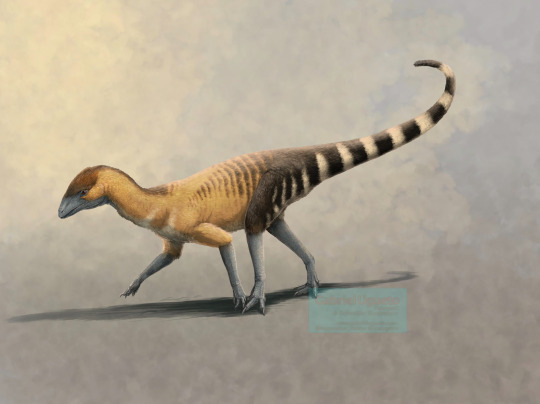
Asilisaurus kongwe, by Gabriel Ugueto
I can make post after post after post explaining WHAT dinosaurs are and HOW birds are living dinosaurs as CLEARLY as I can and point to FREE RESOURCES for people to learn more and yet I *STILL* get ignorant CRAP like this filling my notes EVERY DAMN DAY

dinosaur means a descendant of the most recent common ancestor of Megalosaurus and Iguanodon. "terrible REPTILE" is what we named them because HUMANS NAME THINGS.
birds descended from that ancestor. thus, they are dinosaurs.
neither dinosaurs NOR birds are lizards. lizards are their OWN DAMN HYPERADAPTED THING that are super weird and nothing like birds or dinosaurs.
i am a PALEONTOLOGIST and it SAYS SO IN MY BIO so CLEARLY I KNOW WHAT I AM TALKING ABOUT
you can also GOOGLE THIS. AND GOOGLE WILL TELL YOU THE SAME THING.
like, let's put it this way:
I have known, my entire life, a particular truth about the world. The majority of evidence has continued to support that truth, throughout my 30 years of life.
And yet, every five seconds, I get a million people telling me, with their whole chests, that I am wrong, even though, I am not.
What I'm saying is I'm constantly being gaslit by pretty much all of humanity apart from my comrades in arms and that has, in fact, contributed to my mental health issues.
This is not okay. Willful ignorance is not okay. We all need to be more okay with admitting we don't know things and looking them up. I don't know *lots* of things. And that's okay! I look them up! I learn!
Be okay with being wrong! Be okay with learning!
Stop gaslighting scientists! We're really tired and really scared bc the planet is on fire and no one is listening! Thanks!
3K notes
·
View notes
Text
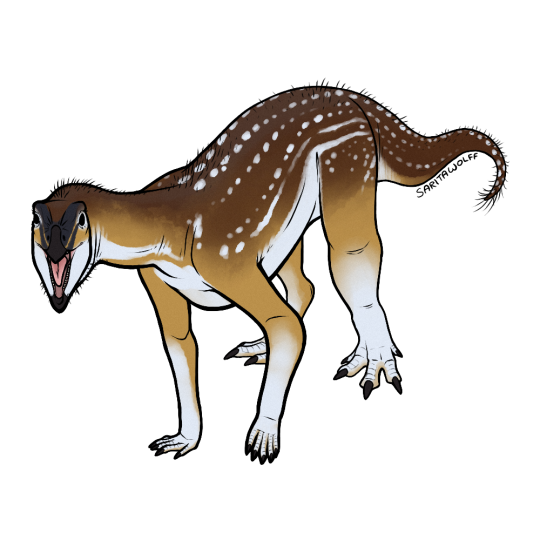
Patreon request for @/rome.and.stuff (Instagram) - Asilisaurus kongwe
Asilisaurus kongwe means “Ancient Ancestor.” As one of the first silesaurs, Asilisaurus is one of the oldest-known Avemetatarsalians (the clade which includes dinosaurs, silesaurs, and pterosaurs.) Found in the Manda Formation of Tanzania, it lived during the earliest portion of the Late Triassic. It appears to have been very common (or at least very prone to fossilization) as it is known from a relatively large amount of fossils.
Based on the length of its limbs, Asilisaurus was likely quadrupedal, but probably could have also reared up on its hind legs. It had no teeth in the tip of its snout, indicating the presence of a small beak, and also had fewer teeth than other silesaurs. Because of this, it is hypothesized that Asilisaurus was an omnivore or even a herbivore. The peglike shape of its teeth may have also lended to piscivory. As silesaurs seemed to have diets which were just as varied as dinosaurs (the Argentinian Lewisuchus was a specialized carnivore, the North American Kwanasaurus was an obligate herbivore, and the Polish Silesaurus was an insectivore and herbivore), Asilisaurus’ diet can’t be based on phylogenetic bracketing.
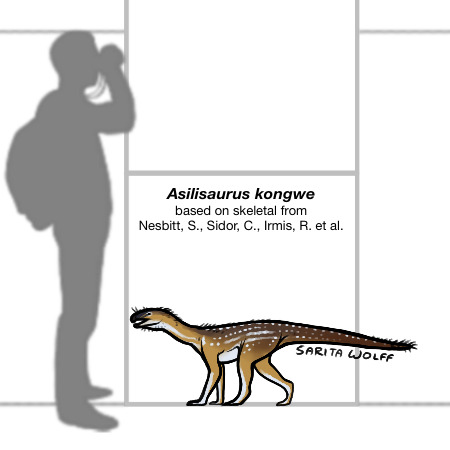
There seem to be two different adult morphologies of Asilisaurus: a “slender” form and a “robust” form. While traditionally regarded as a sign of sexual dimorphism, newer studies show that this could have simply been individual variation and a difference of growth in plentiful vs depleted environments (ie epigenetics), similar to differences seen in Plateosaurus and the modern Alligator.
In the Early Carnian of Tanzania, Asilisaurus kongwe would have lived alongside a variety of pseudosuchians such as Nundasuchus and Mambawakale, as well as the possible early dinosaur, Nyasasaurus. The environment was rich in synapsids as well, including dicynodonts like Angonisaurus, Kannemeyeria, and Tetragonias, and cynodonts like Cynognathus and Diademodon. Asilisaurus would have been preyed on by the aphanosaur Teleocrater and possibly some of the larger, carnivorous cynodonts, which is why I have given it spots for camouflage!
#Asilisaurus kongwe#Asilisaurus#silesaurs#silesaurids#archosaurs#archosauromorphs#reptiles#Manda Formation#Tanzania#Middle Triassic#Late Triassic
64 notes
·
View notes
Text

Just remembered that I forgot to post the original digital version of this piece
#tbh I like this version better but that's probably because I'm still not that good with watercolours#art#my art#digital art#paleoart#paleontology#palaeoblr#archosaurs#silesaurs#silesaurus
19 notes
·
View notes
Text

#Archovember Day 6 - Lewisuchus admixtus
Lewisuchus admixtus was a silesaurid, a type of Triassic archosaur closely related to dinosaurs. Silesaurids all had the same general body plan: a long neck, long legs, and a mostly quadrupedal stance. However, they seem to have all filled a variety of niches. The white-tailed deer-sized Silesaurus was an insectivore. The collie-sized Kwanasaurus was an herbivore. But the smaller, earlier silesaur Lewisuchus was a carnivore, with teeth unique among silesaurids. In fact, its teeth and other anatomical features are so unique that some consider it to be a basal dinosauriform, coming before the silesaurids and dinosaurs split into two groups. It was also found with a single row of osteoderms down its back, something that other silesaurids don’t seem to have. Either way, it was a tiny, unique predator that paved the way for its strange, long-legged cousins.
Living in Late Triassic Argentina, Lewisuchus could have shared habitat with (and probably been hunted by) yesterday’s species, Herrerasaurus. But in the slightly older Chañares Formation, it was more likely to come across Proterochampsids such as Chanaresuchus, Tropidosuchus, and Gualosuchus, and probably competed with them for food. It would have also lived alongside other early dinosauriforms such as Marasuchus, early pterosauromorphs such as Lagerpeton, and the tiny pseudosuchian Gracilisuchus. Cynodonts were plentiful here, and Lewisuchus could have hunted small ones such as Probainognathus.

#my art#SaritaDrawsPalaeo#Lewisuchus#Lewisuchus admixtus#silesaurs#silesaurids#??#archosaurs#archosauromorphs#reptiles#Archovember#Archovember2023
13 notes
·
View notes
Text
Silesaurus. So now "is it a dinosaur or no?" turns into an actual scientific debate
Some of yall will be like "oh whats your favorite dinasaur? Mine's ___" and then name anything but a dinosaur
#more seriously my faves are kelenken penguins sinosauropteryx yi stegouros and kentrosaurus#but silesaurs are definitely silly and i love them#the might-be-dinosaurs-but-we're-not-sure
310 notes
·
View notes
Text

silesaurs
#silesaurus#dinosaurs#sort of??? maybe???? not sure what the current consensus is#paleoblr#paleoart#procreate#digital art
708 notes
·
View notes
Text
Dragons in a Trail of Cryptids

I don't care if this technically was posted in march i uploaded it to deviant art in time this is a february art post lmfao. This was meant to be a birthday gift for @jennywolfgal and her other project Trail of Cryptids. Enjoy!!!
The world of Trail of Cryptids explores an evolutionary history for life on earth. One in which the beasts of our folklore are more fact than fiction. Cryptids and mythological creatures exist and evolved naturally through both expected and unexpected origins.
One such group of organisms are the legendary dragons of countless tales of our world. Here they only recently diversified, but their ancestry dates all the way back to the beginning of the triassic.
Their earliest ancestor was a third offshoot of the Avemetatarslians, the same group of archosaurs that gave rise to the dinosaurs and pterosaurs. Ancient Silesaur-like Paradrakoans lived under their brothers’ shadows for the entire mesozoic period. Only scraping by through the smallest niches and farthest corners of the world like the equally unfortunate mammals.
Once the asteroid hit the earth 66 million years ago and wiped out the dinosaurs and pterosaurs. Only 2 representatives of this once great clade remained. Birds, and a single paradrakoan. A small burrower classified as Fodermasaurus superstes, cheekily named by paleontologists as the spug.
It took a long time for the Drakoans to grow their wings and spread it. At first climbing trees and making burrows, then gliding to ease the falls from the canopy. Then longer webbing on the hands to change direction. And finally learned to flap them to gain height. Countless now dead lineages, finally producing the first Drakoan over 40 million years ago during earth’s late eocene.
Nowadays the Drakoans are a fairly small group. They only consist of roughly 1,116 species. A far cry from their far more successful avian cousins. But nonetheless a monumental achievement relative to their entire evolutionary history.
Some common traits that distinguish the Drakoans from other vertebrates are developed egg-teeth that some species retain well into adulthood. Large auricles or external ears, Keratin horns. And most notably powered flight, evolving independently from their avian cousins.
We’ll start out with the order Avidrakoa. An order of Drakoans unique for possessing fully developed beaks derived from their egg teeth. And a unique wing structure made more out of fur bristles than a tough skin membrane. The Avidrakoans first split the moment the class as a whole first evolved powered flight. Allowing their wings to be this derived
They are not too common, numbering in 148 species in total. Most of which are split between basal bipeds such as thunderbirds and the more derived quadrupeds which include griffins.
The species here is an actual griffin. Gryphon tropicus to be exact. They are apex predators of the rainforests of indonesia. Their deep warm coloration and disruptive stripe conceal them in the forest scenery to ambush prey. And their powered flight lets them hop across islands, making them not only a formidable predator, but a widespread one too.
The most famous members of the Drakoan class are the Eudrakoans, the true dragons. They are characterized by their strong parenting mentalities and a natural ability to breathe fire. Through 4 orifices in the corners of their mouth they spew out a liquid biofuel into the path of a similarly regurgitated and highly reactive gas, igniting the fuel into a stream of flaming liquid.
They are the most widespread group of dragons, totalling at 447 different species. Most species are either small sprawling quadrupeds such as the European forest dragon to erect striding quadrupeds like the legendary Eurasian mountain Tsar
The species representing the True Dragons. Megaloros thereusicthys is a close relative to the Eurasian mountain Tsar. Although unlike their apex cousin this species is a wading piscivore. Using their stilted legs to practically hover over the water and their flexible necks to pluck fish out of the rivers they tread through.
Next up is the order Wyverna, a group of Drakoans distinguished by the development of poison laced quills found in certain places along the body. All interconnected to a set of poison glands in the upper mandible. These glands oddly enough share the same ancestry as the biofuel tanks in the Eudrakoans. And a stiffer wing structure making them obligate bipeds
They are the second most common order of dragons. Numbering at 335 documented species. Including the cockatrice surprising many.
The species pictured here is Ouranodyno chrysokephale. A generalist omnivore with a generalist range across Mexico with a rather extravagant hunting method. They dive-bomb towards their prey and catch them with their mouths. More as showmanship for mates than an actual means to survive. They also have extravagant coloration to warn would-be attackers of their poisonous tail quill that could kill a bison in under a minute
There is the order Wurmiza, the most derived group of dragons recorded. They are distinguished by a near complete lack of hind legs. Fully internalized ears, a streamlined annelid-from body plan, and aquatic to semi-aquatic lifestyle. They are the 2nd rarest order of dragons. Consisting of only 124 documented species. Consisting of the smaller seafaring Ladons and the larger Oceanic sea Serpents.The species used to represent the Wyrms, Pachaktevenator horribilis. Is a medium sized sea serpent found in the Indian ocean. They are notable for their extreme aggression and their mating season being spent on the beach. Draconian elephant seals if you will.
Lastly, despite only being a family. This last group of dragons is peculiar enough to warrant it's own highlight in this introduction. The Neosaurs are in a way a twisted mirror of the beasts of the past. They are notable for a complete lack of wings, reduced horns and aurica. But are most recognizable for the Theropod-like body plan most Neosaurs display. Which is speculated to be a consequence for their ancestors having stiff wings like their Wyvern cousins.
They are a very rare order, there are only about 62 species documented. Most of them are found across africa as smaller generalists. But a few can get big enough to recapture what the original dinosaurs had lost
Representing the Neosaurians, the Kasaii asymneter is a south african desert dwelling relative to the legendary Kasaii rex of the southern congo rainforest. They are both pursuit hunters and act relatively similar. The main difference is the prey selection and differenc coloration.
#speculative zoology#spec bio#speculative biology#my art#artist on tumblr#art#worldbuilding#dragon art#year of the dragon#wyvern#creature#creature art
81 notes
·
View notes
Note
What is the particular reason you decided to feature silesaurs on your blog only now, given that the current version of the hypothesis was proposed back in 2020?
The fact that it was proposed then doesn't mean that it was widely accepted at the time. Until recently, I chose to err on the side of caution and stick with the conventional hypothesis that silesaurids were non-dinosaurs while waiting to see how the scientific consensus would develop. At this point though, I think there's been enough corroboration from independent research teams and datasets (most notably Cau, 2024 and Fonseca et al., 2024) to tentatively consider ornithischian silesaurids the leading hypothesis for the moment.
15 notes
·
View notes
Text
Spectember D27: Revamp the Dinosauroid

The end of the Triassic propitiated finally the dominance of dinosaurs in the next period with the rupture of the large supercontinent Pangea, though in this timeline something pushed further the fragmentation of the continent, and instead of just opening the rift of the Atlantic, it multiplied across Africa and a section of south America, making the Tr/J mass extinction more severe and killing out many more species of dinosaurs, so now the Jurassic was no longer dominated by the animals we have in our timeline, instead we get a strange variety of large dinosaur-like crocodiles, many sauropodomorphs that diverged from the smaller species that survived and never went into the same trend of gigantism as in our earth, many synapsids and so on. At the end of the late Jurassic a lot happened with the new order, within some of the second radiation of sauropodomorphs included varied carnivorous carnosaur-like species, medium size coelurosaur-like omnivores and smaller herbivores that look like silesaurs; from the omnivore lineage that have expanded in varied niches would rise a branch of semiaquatic species that resembled something like a scaly penguin with hands, long finger and claws, with short robust tails, shorter necks and longer heads with narrow keratinized mouths.
They are remarkable as many other animals of this world, through one particular species seems to have started a peculiar evolutionary trend in the last 10 million years.
For the reader, we will refer to this species as the Shagoids, a species originated from 50 cm long aquatic sauropodomorph descendants that wandered on the estuaries of the now more fragmented north Africa/south American region, their ancestors were more of a mix of a cormorant with an otter as unlike the rest of its own family this belongs, as one main feature of these are they still functional forelimbs, these still preserved functional arms and hands that helped them to manipulate their prey of crustaceans and mollusks. Over time these developed strategies to break down their prey shell, including the habit of picking and using stones which choose appropriately for this task. This behavior was passed on to new generations, learned and properly helped them to get food with less effort, the food quality increased brain energy, brain size also increased and so their skills were forged much more adequately.
It was on matter of few million years the Shagoids lineage abandoned their swimming lifestyle and became mostly semi aquatic coastal dwellers, living in the shores and just entering water to hunt their food rather than spending most of their time there. As social animals they formed hierarchy groups, formed by the head of a dominant female around minor males that could either mate with her or just serve them, as well many other younger individuals, matriarchs often had the duty to select and organize hunting and spending of food, as well regulate reproduction and mating between their lower family, as she normally is the eldest of the group, and only another female of the same blood can turn into a elder matriarch of if mated by the son of the elder, this perhaps was the moment they gained proper sentience as how they defined a cultural and social structure.
It seems at the end rathe in a sudden change of sea level in the last 3 million years did the final push on their evolutionary journey, as most of the Shagoid populations got stranded within the main continent with almost no way to find new connections to large water bodies, in other situation their species would have die for starvation, but at that point they were already adapted to feed on other food sources, from tubers, insects and small animals, being able to cook them using fire they managed to craft, and so properly passed the harsh time with the loss of a chunk of their population over the sudden change.
When the Shagoid expanded and found again large water bodies far from their native regions, they really have changed considerable from their ancestors, as their closest relative was a sort of strange loon like reptilian species wandering in the coasts, these were more like limbed penguins with long arms and tridactyl hands, which the third finger being a derivation of the 4th an 5th clawless digit fused into one, their short legs lost their webbed feet a while ago and are more adapted for walking, their head still preserve the characteristic seabird like shape but their teeth have changed in shape to be generalistic omnivore, with a large head which houses the most intelligent brain in the planet.
Over the last thousands of years, they have been becoming more and more prone to establish permanent settlements populated by hundreds of them much more different of their wandering tribes, often farm plants and even carry some animals for domestication.
For the first time in their history they are in the pathway of civilization… who knows what will happen next, either the Shagoid can remain like this until their extinction, or they will start building towards the sky and beyond.
#speculative evolution#alternative evolution#triassic#jurassic#sauropodomorph#dinosauroid#sapient#spectember
36 notes
·
View notes
Text
No guarantee disclaimer: This product may or may not include sillysaurs. Use it at your own risk.
Birds are Dinosaurs
Dinosaurs are defined as "The Most Recent Common Ancestor of Megalosaurus (the first dinosaur named) and Iguanodon (the second dinosaur named) and ALL of that ancestors descendants"
This includes birds, because they evolved from dinosaurs
It does not include lizards, snakes, tuatara, crocodilians, turtles, cockroaches, Dimetrodon, pterosaurs/pterodactyls, plesiosaurs, ichthyosaurs, mosasaurs, sharks, frogs, salamanders, or a single mammal.
It does include every single bird.
The end.
598 notes
·
View notes
Text
Archovember 2024 Day 15 - Saturnalia tupiniquim

The Late Triassic Saturnalia tupiniquim was one of the earliest dinosaurs. While around 1.5 metres (4.9 ft) long and weighing between 4 and 11 kilograms (8.8 and 24.3 lb), Saturnalia was in fact an early sauropodomorph, ancestral to the long-necked giants who would one day tower over all other dinosaurs. Unlike its descendants, it was a carnivore or omnivore, eating arthropods or small vertebrates. Its long body and neck would have allowed it to dart its head rapidly after fast, elusive prey.

Living in Brazil’s Alemoa Member of the Santa Maria Formation, Saturnalia would have lived in a coastal environment. It could have lived alongside other early archosaurs like fellow sauropodomorphs Buriolestes, Nhandumirim, and Pampadromaeus, the lagerpetids Ixalerpeton and Venetoraptor, and the silesaur Amanasaurus, as well as other archosauromorphs like the proterochampsids Cerritosaurus and Proterochampsa. It would have also lived alongside a variety of synapsids like the cynodonts Exaeretodon, Alemoatherium, Charruodon, Gomphodontosuchus, Prozostrodon, and Therioherpeton. Saturnalia could have been hunted by the pseudosuchians Rauisuchus and Dynamosuchus and the herrerasaurids Gnathovorax and Staurikosaurus.

This art may be used for educational purposes, with credit, but please contact me first for permission before using my art. I would like to know where and how it is being used. If you don’t have something to add that was not already addressed in this caption, please do not repost this art. Thank you!
#Sorry this is late#the Executive Dysfunction hit hard#Saturnalia tupiniquim#Saturnalia#sauropodomorphs#saurischians#dinosaurs#archosaurs#archosauromorphs#reptiles#Archovember#archovember2024#Dinovember#Dinovember2024#SaritaDrawsPalaeo#Late Triassic#Brazil#Santa Maria Formation
42 notes
·
View notes
Text

Recently I managed to find my old watercolours that I got when I was at my (previous) school and I finally got around to testing them out. While this piece has several mistakes I'm not gonna be too harsh on myself since I haven't worked with watercolours since 2022.
#art#my art#traditional art#watercolour#paleoart#paleontology#palaeoblr#archosaurs#silesaurs#silesaurus#queue#also I have a digital mockup of this so if anyone wants to see that lmk
19 notes
·
View notes
Text
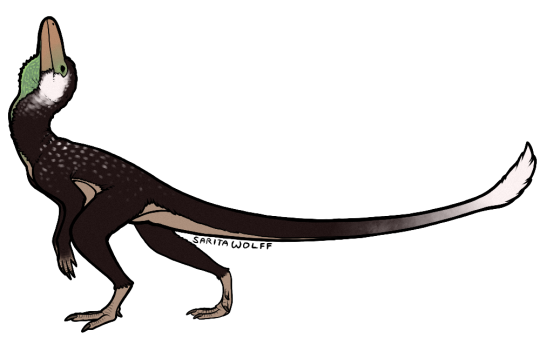
#Archovember Day 26 - Ixalerpeton polesinensis
The Triassic lagerpetids were once thought to be early dinosauromorphs, but recent fossil evidence suggest that they were actually pterosauromorphs… either closely related to pterosaurs or even ancestral to them! Ixalerpeton polesinensis was a lagerpetid from Late Triassic Brazil, a locale that would eventually become a hotspot for pterosaurs. Like other lagerpetids, it had long hind legs with well-developed muscles, but it lacked the neural spines that suggest hopping locomotion as in Lagerpeton. It was small and agile, likely using its long legs to chase and leap after insects.
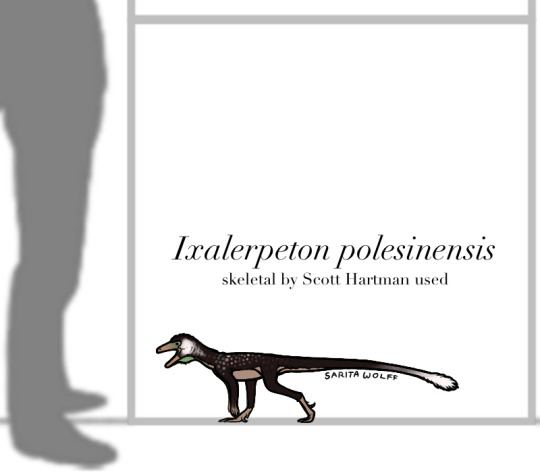
In the Upper Santa Maria Formation, Ixalerpeton would have had to watch out for large predatory pseudosuchians like Rauisuchus and herrerasaurids like Staurikosaurus and Gnathovorax. It also lived alongside early aetosaurs Aetobarbakinoides and Aetosauroides, silesaurs like Amanasaurus, and basal sauropodomorphs Buriolestes and Saturnalia. There were also a variety of cynodonts, like Gomphodontosuchus and Prozostrodon, and the temnospondyl amphibian Compsocerops.
#my art#SaritaDrawsPalaeo#Ixalerpeton polesinensis#Ixalerpeton#lagerpetid#pterosauromorphs#archosaurs#archosauromorphs#reptiles#Archovember#Archovember2023
19 notes
·
View notes
Text
If you're not a friend of the Silesaurs, then you're no friend of my mine.
0 notes
Text
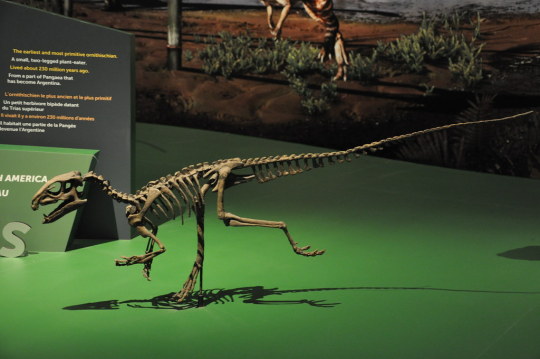

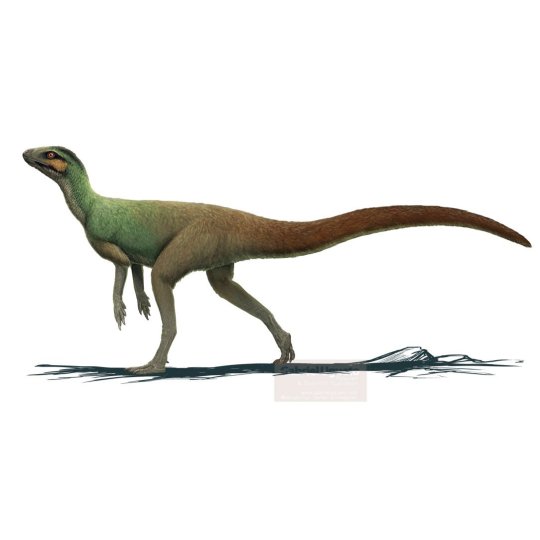
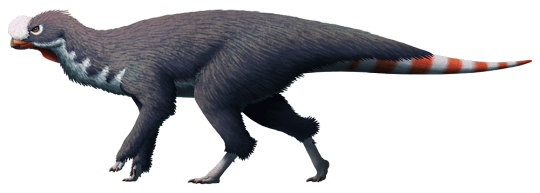
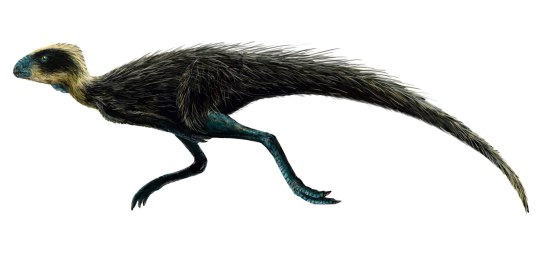
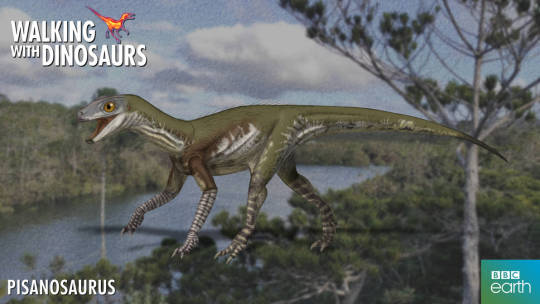
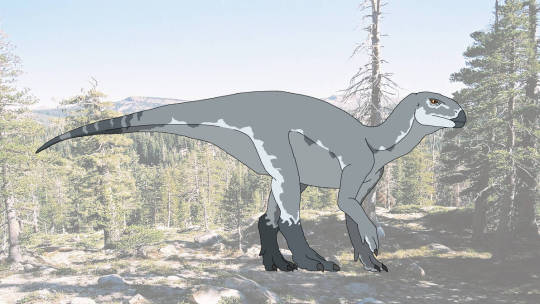
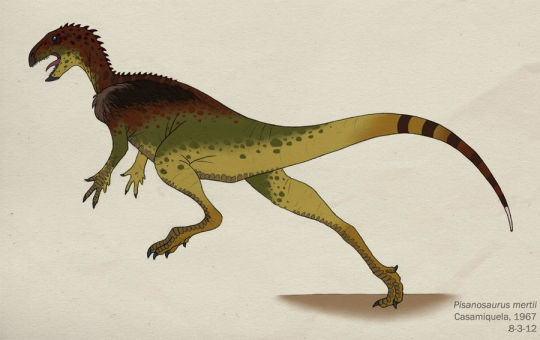
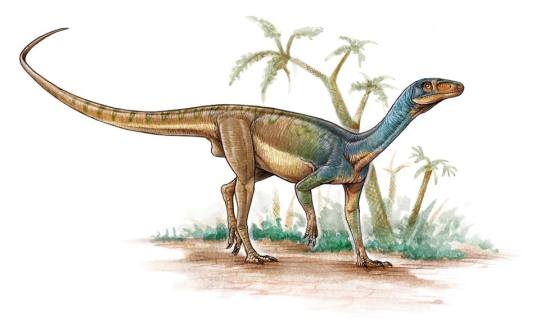
Pisanosaurus is an extinct genus of early dinosauriform reptile which lived throughout what is now South America during the Carnian stage of the Triassic period some 231 to 227 mya. The first and only known specimen of Pisanosaurus consisting of a single partial skeleton was unearth in 1962 by Galileo Juan Scaglia at the Hoyada del Cerro Las Lajas locality in the Ischigualasto Formation of La Rioja Province, Argentina. It was later described by Argentine paleontologist Rodolfo Casamiquela in 1967 who named the animal Pisanosaurus meaning "Pisano’s lizard" in honor of Argentine paleontologist Juan Arnaldo Pisano of La Plata Museum. With the species name mertii being a reference to the late Araucanian naturalist Carlos Merti. Reaching around 3.3 to 4.3ft (1 to 1.3m) in length and 4 to 5lbs (1.8 to 2.7kgs) in weight, Pisanosaurus was a small and lightly built facultative biped animal. Due in part to its fragmentary nature, Pisanosaurus has been variously interpreted as being either a very basal ornithischian dinosaur, perhaps the earliest known, or as being a silesaurid: a group of non-dinosaur dinosauriform archosaurs. The placement of Pisanosaurus is reliant on the placement of silesaurids as a whole, a situation which in itself is of much debate. While Silesauridae is often considered a monophyletic sister group of dinosaurs, some studies consider it a paraphyletic grade ancestral to ornithischian dinosaurs as a whole. There in Pisanosaurus could have been both a silesaur and a primitive ornithischian. Reguardless of its taxonomic position, pisanosaurus was a small herbivore with likely spent its life in the underbrush of coniferous forests feeding upon various vegetation such as ferns and horsetails.
Art used in can be found at the links below
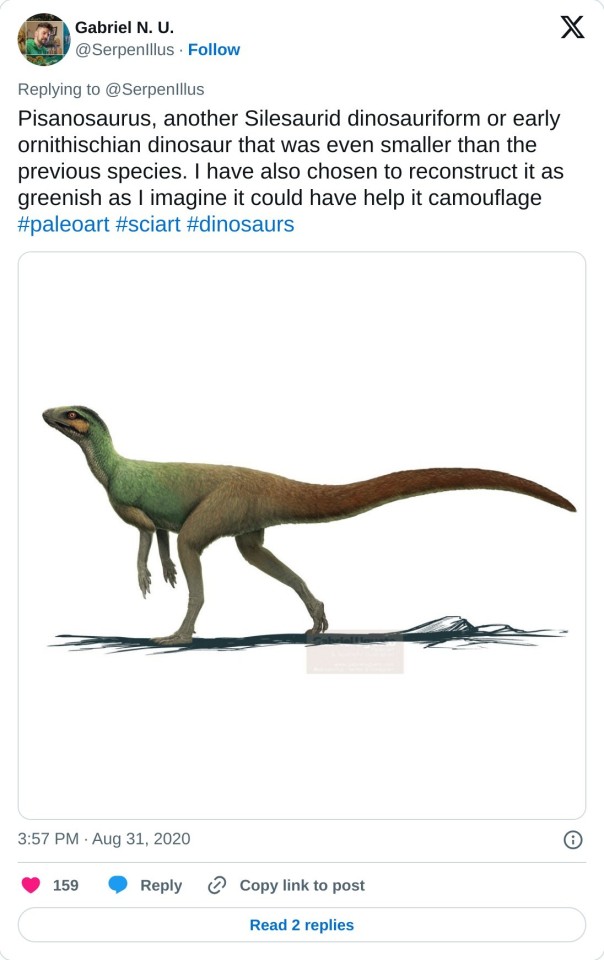
#pleistocene pride#pliestocene pride#mesozoic#triassic#pisanosaurus#dinosaur#dinosaur day#silesaurid#ischigualasto formation
1 note
·
View note